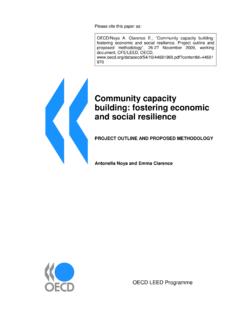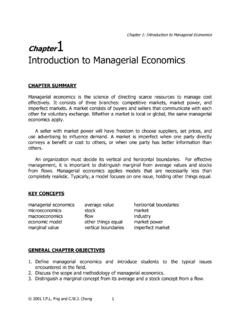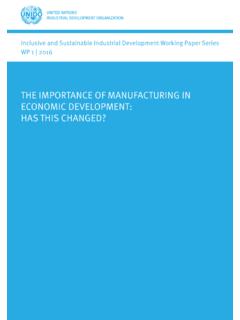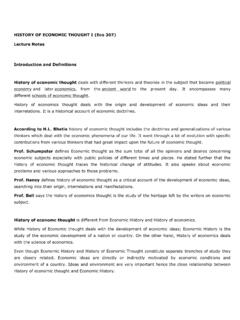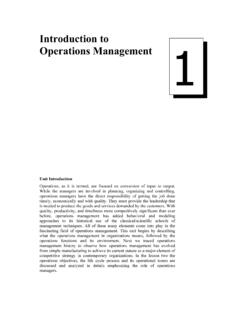Transcription of An Introduction to Accounting Theory - SAGE Publications Inc
1 1 Accounting is frequently viewed as a dry, cold, and highly analytical discipline with very precise answers that are either correct or incor-rect. Nothing could be further from the truth. To take a simple example, assume two enterprises that are otherwise similar are valuing their inventory and cost of goods sold using different Accounting methods. Firm A selects LIFO (last-in, first-out) and Firm B selects FIFO (first-in, first-out), giving totally different but equally correct , one might say that a choice among inventory methods is merely an Accounting construct : the kinds of games accountants play that are solely of interest to them but have nothing to do with the real world. Once again this is totally incorrect. The LIFO versus FIFO argument has important income tax ramifications in the United States, resulting under LIFO in a more rapid write-off of current inventory costs against 1An Introduction to Accounting TheoryCHAPTERA fter reading this chapter, you should be able to: Understand the meaning of Accounting Theory and why it is an important topic.
2 Understand the relationship between Accounting Theory and policy making. Understand what measurement is and its role in Accounting . Gain insight into the principal valuation systems in Objectives2 Accounting Theory revenues (assuming rising inventory prices), which generally means lower income taxes. Thus an Accounting construct has an important social real-ity : how much income tax is tax payments are not the only social reality that Accounting numbers affect. Here are some other examples: 1. Income numbers can be instrumental in evaluating the performance of management, which can affect salaries and bonuses and even whether individual management members retain their jobs. 2. Income numbers and various balance sheet ratios can affect dividend payments. 3. Income numbers and balance sheet ratios can affect the firm s credit standing and, therefore, the cost of capital. 4. Different income numbers might affect the price of the firm s stock if the stock is publicly traded and the market cannot see through the Accounting methods that have been Accounting numbers can have important social consequences, why is it that we cannot always measure economic reality accurately?
3 Different perceptions exist of economic reality. For example, on the one hand, we may say that the value of an asset is equal to the amount paid for it in markets in which the asset is ordinarily acquired, or, on the other hand, some may see an asset s value represented by the amount the firm can acquire by selling the asset. These two values are not the same. The former value is called replacement cost or entry value, and the latter is called exit value (these are not the only possible value choices). Both values are dis-cussed in the appendix to this chapter and in Chapter 14. Exit values are usu-ally lower than entry values because the owning enterprise does not generally have the same access to buyers as firms that regularly sell the asset through ordinary channels. Hence, there is a valuation choice between exit and entry values. Suppose, however, that we take the position that both of these valua-tions have merit but they are not easy to measure because market quotations are not available and users may not understand what these valuations mean.
4 Hence, a third choice may arise: historical cost. While entry and exit values represent some form of economic reality, the unreliability of the measure-ments may lead some people to opt for historical cost on the grounds that users understand it better than the other two approaches and measurement of the historical cost number may be more question we have just been examining, the choice among account-ing values, including historical cost, falls within the realm of Accounting An Introduction to Accounting Theory 3theory. There are, however, other issues that arise in this example, both implicit and explicit: 1. For what purposes do users need the numbers ( , evaluating man-agement s performance, evaluating various aspects of the firm s credit standing, or even using the Accounting numbers as an input for predicting how well the enterprise will do in the future)?2 2. How costly will it be to generate the desired measurement?
5 The choice among the different types of values, as well as the related issues, falls within the domain of Accounting Theory . The term Accounting Theory is actually quite mysterious. There are many definitions throughout the Accounting literature of this somewhat elusive term. Accounting Theory is defined here as the basic assumptions, definitions, principles, and con-cepts and how we derive them that underlie Accounting rule making by a legislative body. Accounting Theory also includes the reporting of account-ing and financial information. There has been and will continue to be exten-sive discussion and argumentation as to what these basic assumptions, definitions, principles, and concepts should be; thus, Accounting Theory is never a final and finished product. Dialogue always continues, particularly as new issues and problems arise. As the term is used here, it applies to finan-cial Accounting and not to managerial or governmental Accounting .
6 Financial Accounting refers to Accounting information that is used by investors, creditors, and other outside parties for analyzing management performance and decision-making interpret the definition of Accounting Theory broadly. Clearly, the drafting of a conceptual framework that is supposed to provide underlying guidance for the making of Accounting rules falls within the coverage of Accounting Theory . Analyzing Accounting rules to see how they conform to a conceptual framework or other guiding principles likewise falls within the Accounting Theory realm. While the actual practice of Accounting is generally of less theoretical interest, questions such as why firms choose particular methods when choice exists (the LIFO versus FIFO question, for example) are of theoretical interest because we want to know the reasons underlying the choice. In a pragmatic sense, one can say that Accounting Theory is con-cerned with improving financial Accounting and statement presentation, although, because their interests are not exactly the same, conflict may exist between managers and investors, and among other groups, relative to the issue of what improves financial can also examine the types of topics, issues, and approaches dis-cussed as part of Accounting Theory .
7 In addition to conceptual frameworks 4 Accounting THEORYand Accounting legislation, Accounting Theory includes concepts ( , real-ization and objectivity), valuation approaches (discussed in Appendix 1-A), and hypotheses and theories. Hypotheses and theories are based on a more formalized method of investigation and analysis of subject matter used in academic disciplines such as economics and other social sciences employ-ing research methods from philosophy, mathematics, and statistics. This newer and more formal approach to the development of Accounting Theory is a relatively recent innovation in our field and permeates much of the cur-rent Accounting research. Researchers are attempting to analyze Accounting data to explain or predict phenomena related to Accounting , such as how users employ Accounting information or how preparers choose among Accounting analyses and investigation of Accounting data are discussed in Chapter 2.
8 The results of the research process are published in books and journals (academic and professional) devoted to advancing knowledge of financial Accounting as well as other branches of Accounting , such as cost and management Accounting , auditing, taxes, and systems. Various facets of Accounting Theory are discussed throughout this begin by briefly examining the relationship between Accounting Theory and the institutional structure of Accounting . One of the objectives of this book is to assess the influence of Accounting Theory on the rule-making process. Hence, the approach adopted here is concerned with the linkages (and often the lack thereof) between Accounting Theory and the institutions charged with promulgating the rules intended to improve Accounting practice. Closely related to Accounting Theory is the process of measurement. Measurement is the assignment of numbers to properties or characteristics of objects.
9 Measurement and how it applies to Accounting are introduced in this chapter and appear throughout the text. The appendix to the chapter briefly illustrates the principal valuation approaches to account-ing. These valuation methods are concerned with the measurement of eco-nomic phenomena. They are discussed in more depth in Chapter 14, but they are also referred to in the intervening chapters on Accounting Theory and Policy MakingThe relationship between Accounting Theory and the standard-setting pro-cess must be understood within its wider context, as shown in Exhibit We caution that Exhibit is extremely simplistic. economic conditions have an impact on both political factors and Accounting Theory . Political fac-tors, in turn, also have an effect on Accounting Theory . For example, after the An Introduction to Accounting Theory 5 Statement of Financial Accounting Standards (SFAS) No. 96 on income tax allocation appeared in 1987, several journal articles as well as corporate preparers of financial statements severely criticized it.
10 Eventually, political factors (see the following discussion regarding the costliness and difficulty of implementing SFAS No. 96) led to its replacement by SFAS No. 109. Despite its simplicity, Exhibit is a good starting point for bringing out how ideas and conditions eventually coalesce into policy-making decisions that shape financial such as the Financial Accounting Standards Board (FASB) and the Securities and Exchange Commission (SEC), which are charged with making financial Accounting rules, perform a policy function. This policy function is also called standard setting or rule making and specifically refers to the process of arriving at the pronouncements issued by the FASB, the SEC, or the International Accounting Standards Board (IASB). The inputs to the policy-making function come from three main (although not necessar-ily equal) sources: economic factors, political factors, and Accounting Theory .










